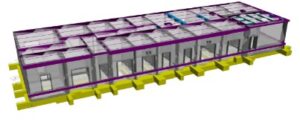
A rendering shows what the new, 5,000-square-foot combustion lab at NSWC Indian Head could look like.
By Sheila Mullowney, NAVSEA Warfare Centers Headquarters Corporate Communications: The Navy will be getting a long-needed, state-of-the-art combustion laboratory at Naval Surface Warfare Center (NSWC) Indian Head Division, thanks to a new federal funding program aimed at upgrading defense laboratories.
The Central Laboratory Investment Program (CLIP) was established by the Office of the Under Secretary for Defense for Research and Engineering in fiscal year 2022 to fund the development of high-priority science and technology (S&T) capabilities across the Department of Defense (DoD) for service requirements related to critical technology areas.
Authorized by the National Defense Authorization Act, CLIP recognizes that the annual military construction (MILCON) budget alone is not enough to keep up with the needs of laboratories across the DoD.
“DoD’s Research, Development, Test and Evaluation (RDT&E) infrastructure plays a critically important role in the department’s ability to provide its warfighters vital military capabilities. … The increasing age of the department’s RDT&E infrastructure, along with limited modernization investments, impacts the DoD’s ability to keep pace with evolving technologies and deliver future warfighting capabilities,” according to the call for proposals.
Among the CLIP awards this fiscal year, $6 million was approved to build a new, approximately 5,000-square-foot standalone combustion testing facility at NSWC Indian Head Division. The lab will include blast protection, detonation chambers and hydraulic presses that meet Ammunition and Explosive Safety Ashore requirements for safely handling explosive material. The project – which will provide for multi-functional small-scale mixing, pressing, detonation and combustion – supports the critical technology area of Advanced Materials.
Building the new combustion lab will not only enable continuity of mission for explosive RDT&E operations, but expand RDT&E capability in a flexible, consolidated, efficient facility with scale-up capacity – a key factor for the CLIP.
“One of the focuses for CLIP is looking at R&D capabilities that benefit the broader DoD,” said Josh van Schagen, infrastructure manager for Warfare Centers Headquarters. “Energetics, explosive test capabilities – those are relatively unique.”
Although NSWC Indian Head Division is the Navy’s only arsenal, it also performs work for other branches of the military, including the Army, Air Force and Department of Homeland Security. The command received Center for Industrial and Technical Excellence designation in May 2014 for both depot maintenance and military arsenal activities.
The new lab will relocate explosive testing operations from a building which was built in the 1950s. Because of its age and condition, explosive test limits have had to be reduced, according to NSWC Indian Head Division Infrastructure Division Program Manager Brian Barger. With that building unable to be upgraded to meet requirements, a study was conducted in 2016 to evaluate the possibility of constructing an addition to another building to house explosive testing operations. That study determined the addition was not feasible, either, and a new standalone combustion laboratory was required. The new building also will separate research and manufacturing activities, which had been co-located in the previous facility.
“They really need their own facility,” Barger said. “It’s satisfying to be building a new building. Most of what we do is sustainment or modernization, but at the end of the day, it’s still the same old building.”
Design was completed in 2022 and construction is expected to take 16 months, pending Naval Ordnance Safety and Security Activity (NOSSA) and Department of Defense Explosives Safety Board (DDESB) site approval, which is in progress.
The new facility will be a boon not only to the command’s customers, but its workforce, Barger said. “The very least we can do is provide the best facilities to do the work in,” he said. “An important part of having these new facilities is (attracting and retaining) people. People are our best asset here.”
The command’s new lab is the first Naval Sea Systems Command (NAVSEA) Warfare Center project to receive CLIP funding – and infrastructure officials said they hope it won’t be the last. Several Divisions have submitted proposals for funding in fiscal year 2024, van Schagen said.


